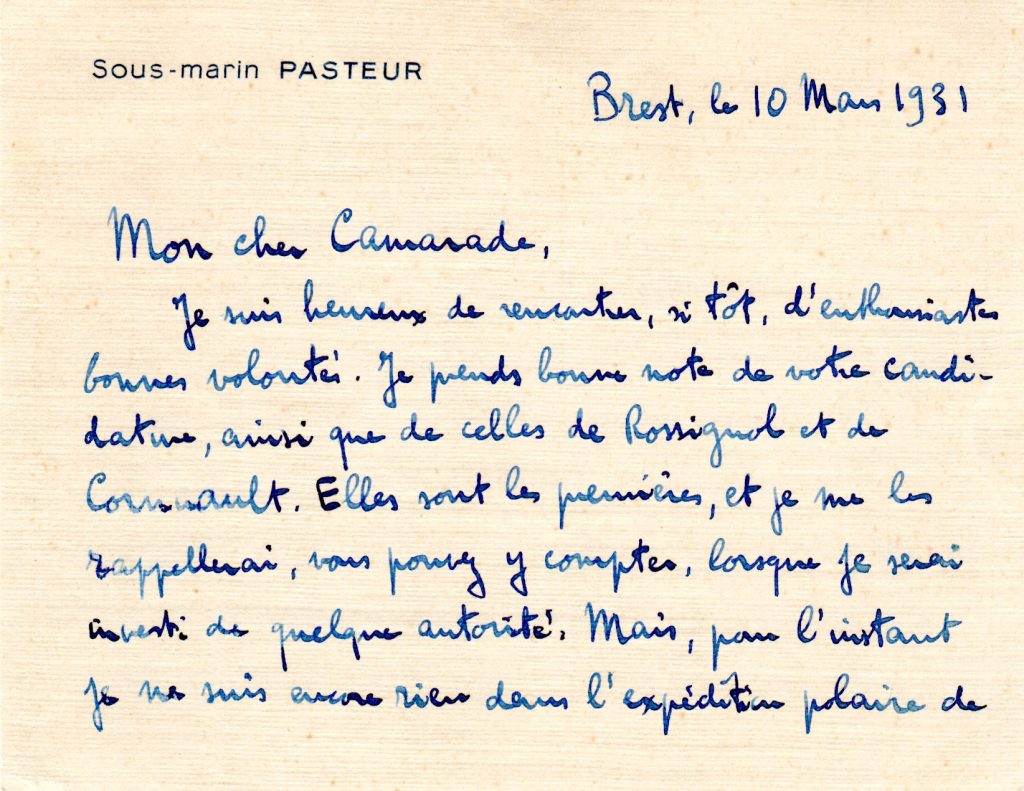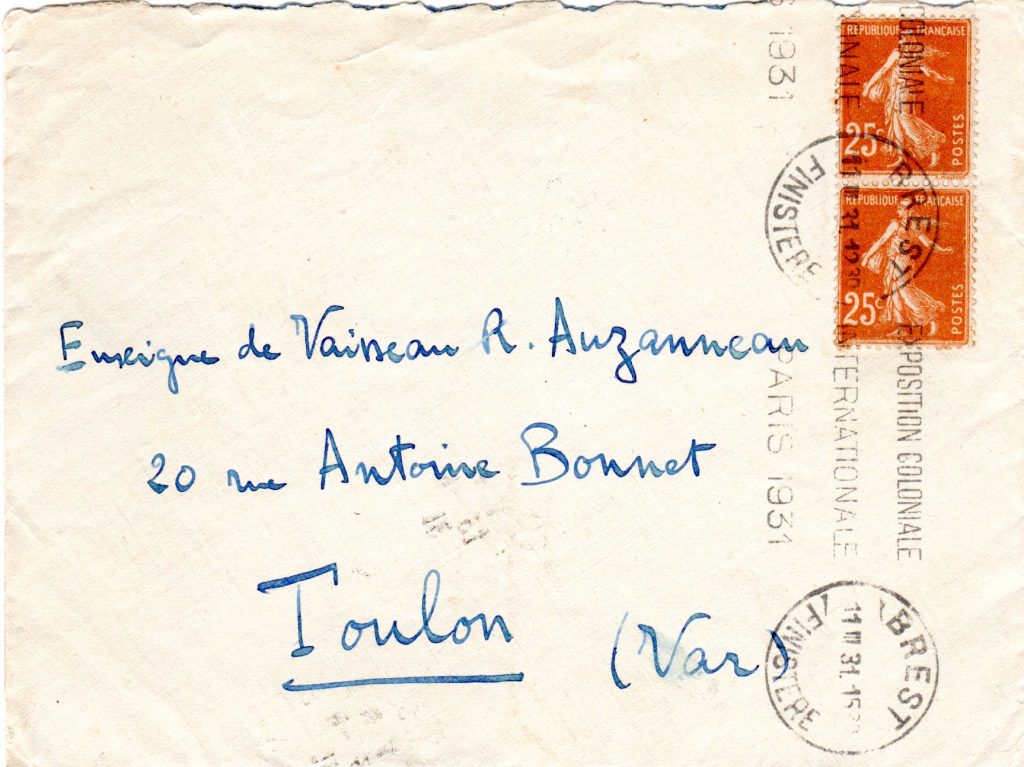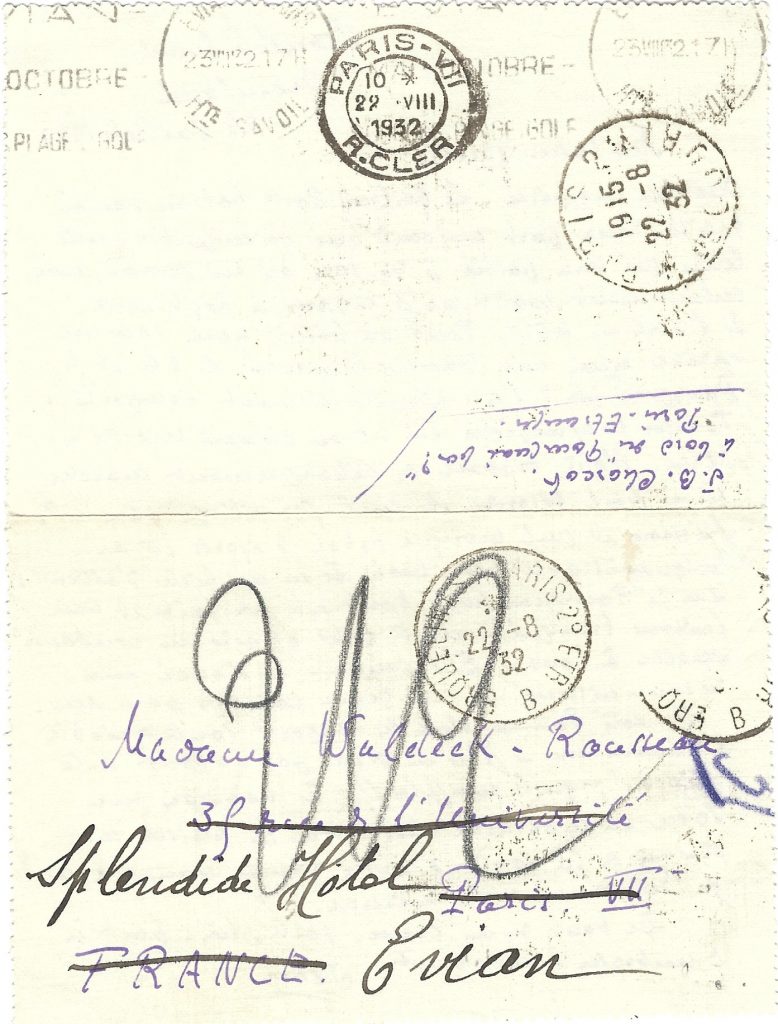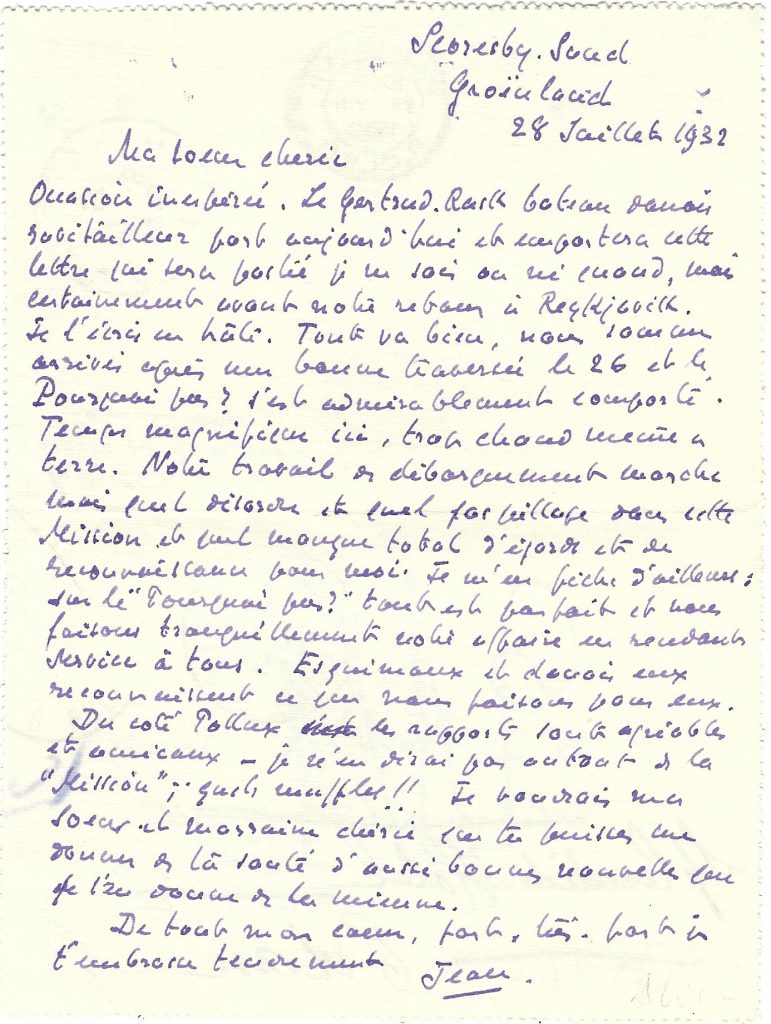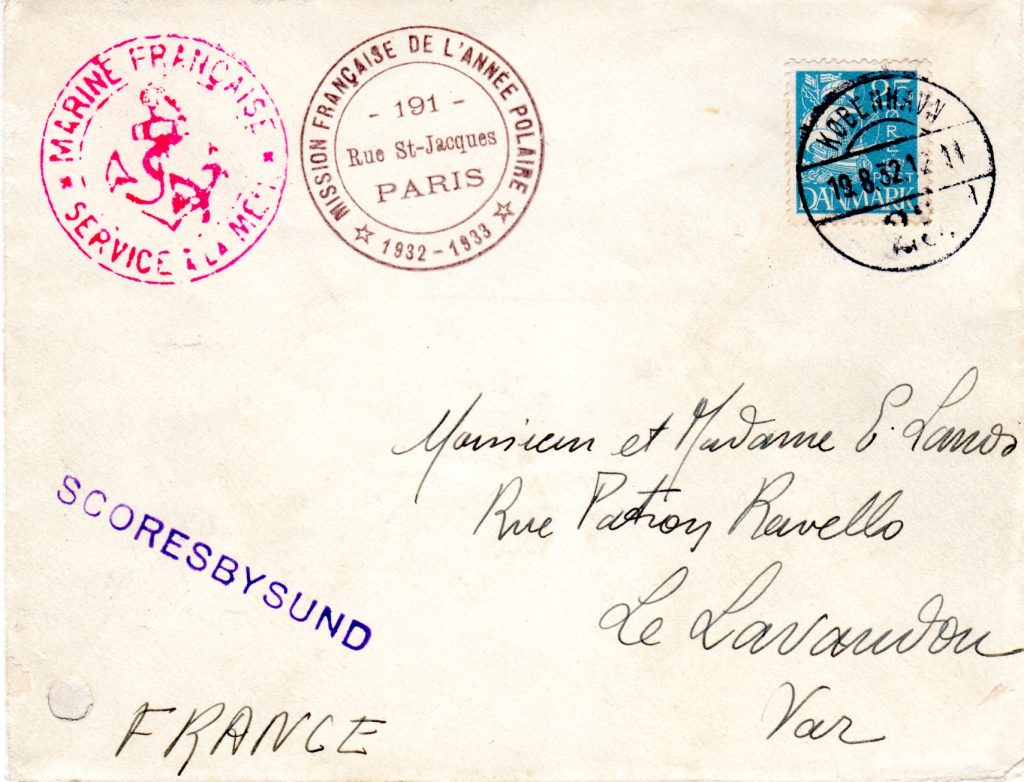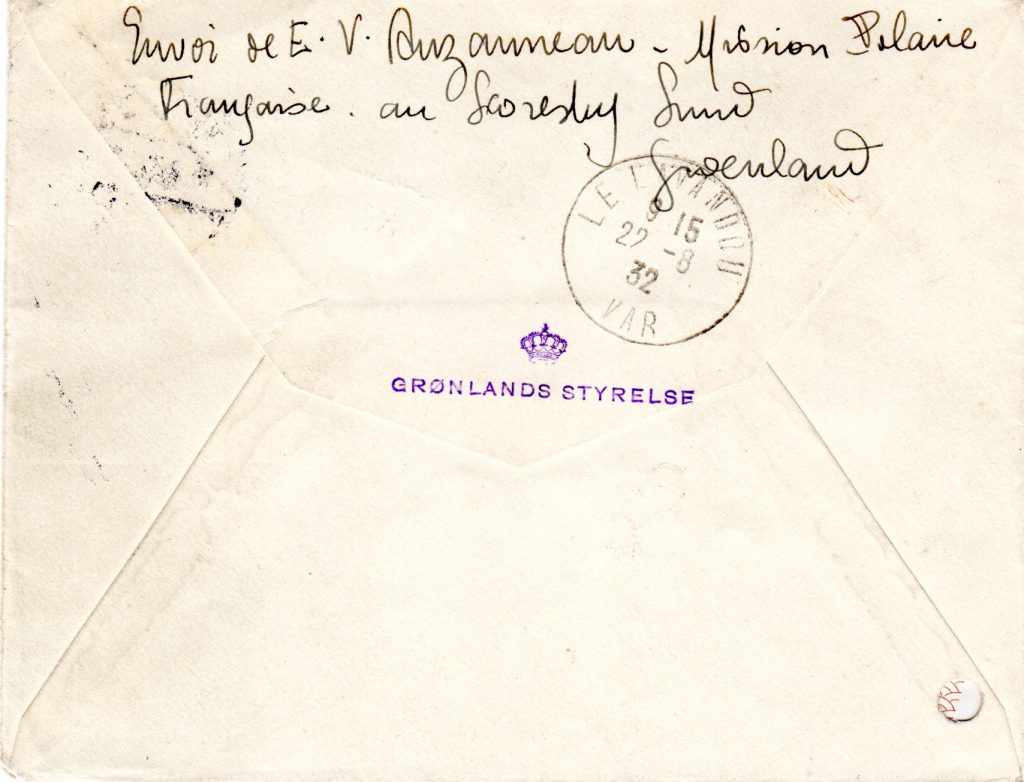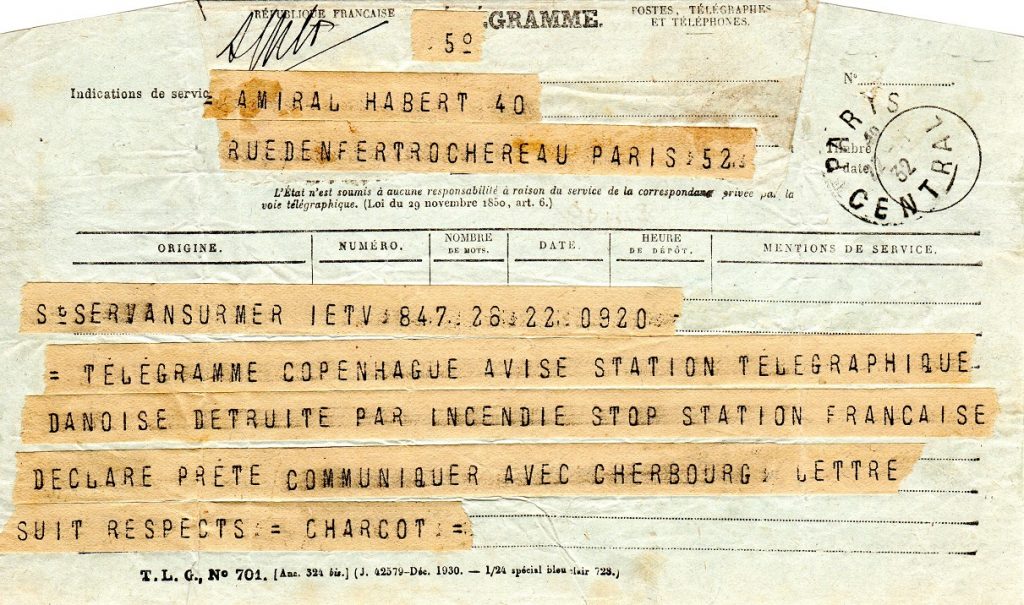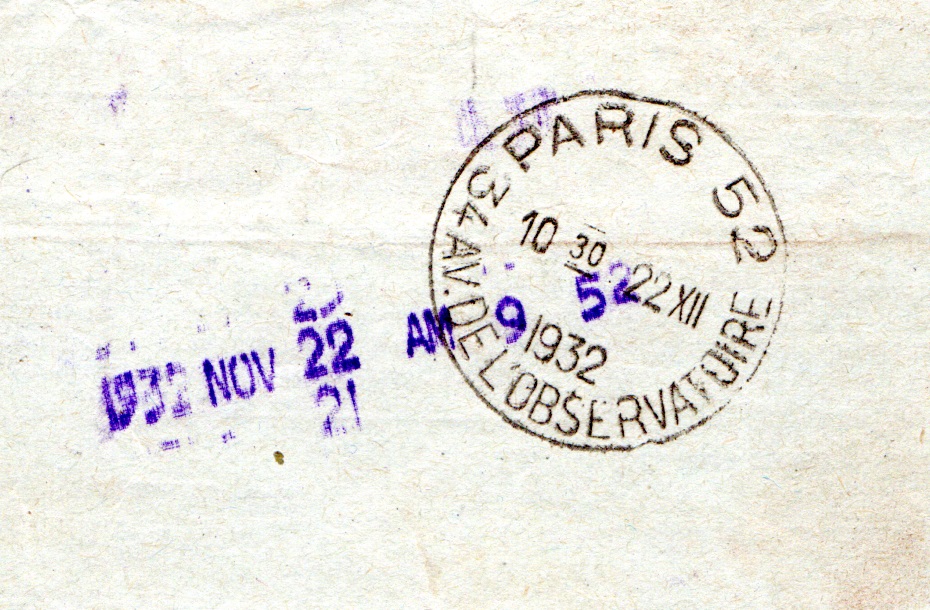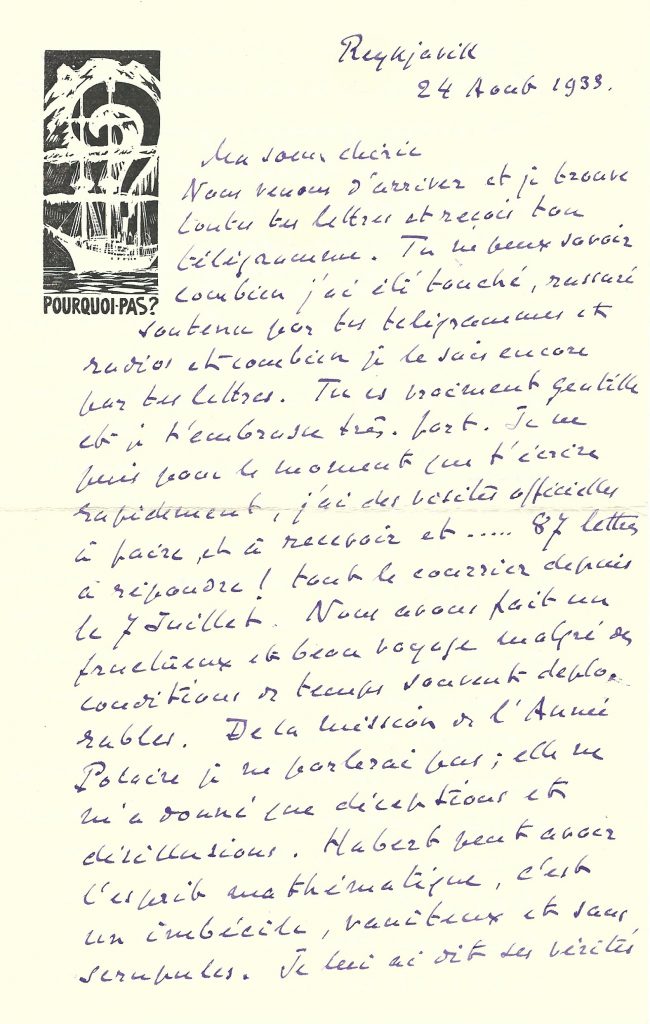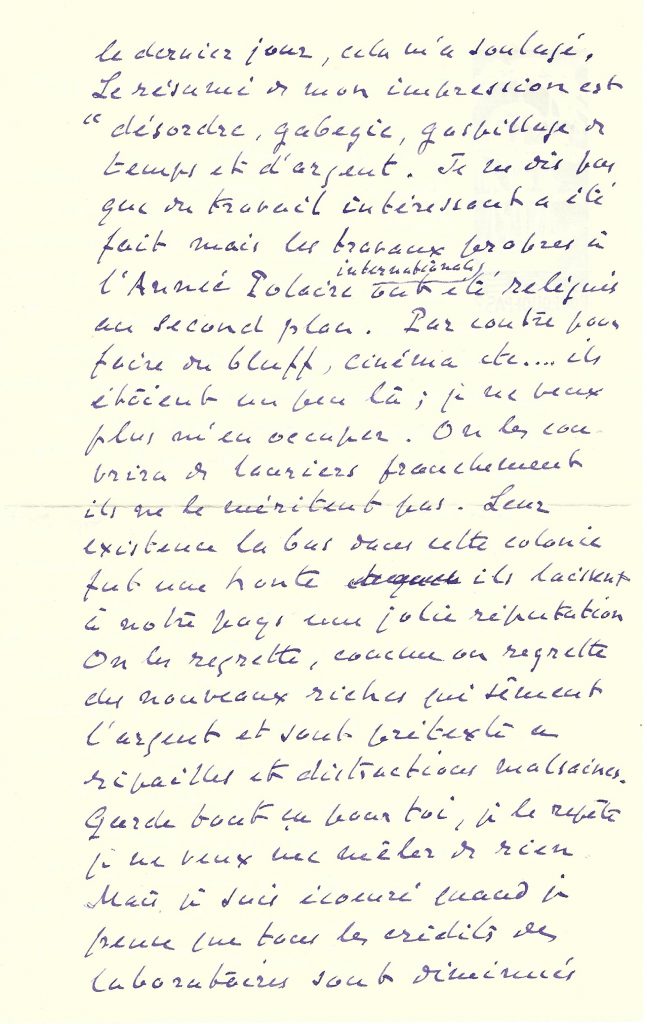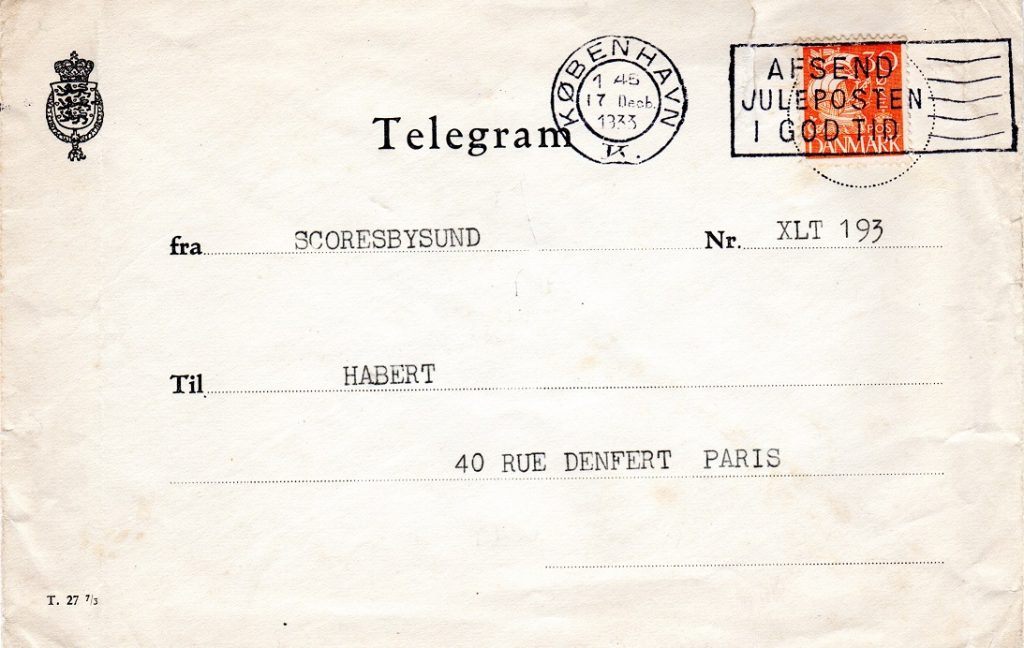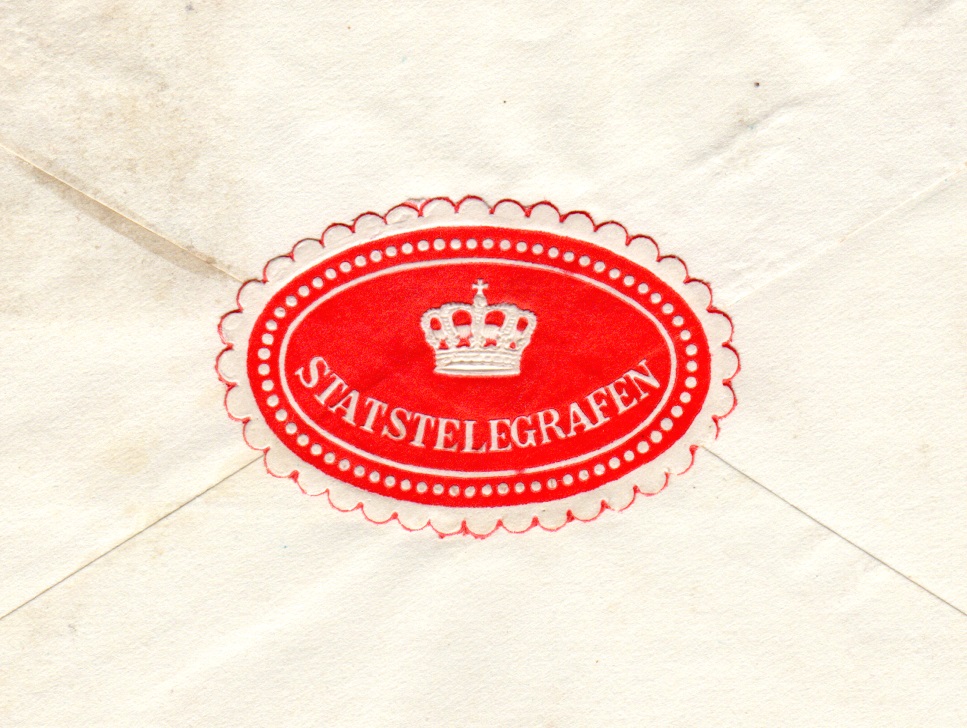French Participation in the 2nd IPY
French Participation in the 2nd International Polar Year 1932-33
Serge Kahn
In 1873, the Austrian Weyprecht put forward the idea of an important scientific event whose project was developed at the International Congress of Meteorology in Rome in April 1879, then in Hamburg the same year, in Bern in 1880 and in St. Petersburg in 1881. The aim was to establish a series of stations in the Polar Regions where simultaneously, with similar methods and instruments, for a whole year, specialists of various nationalities would carry out observations and research in meteorology and terrestrial magnetism. Eleven nations joined the project, which was carried out as agreed from 1882 to 1883. It was the first International Polar Year (IPY).
1 – Preparation for 2nd IPY participation 1930-31
Fifty years after the first IPY, the project to organize a new Polar Year 1932-33 was issued by the International Meteorological Committee and approved by the General Assembly of the International Union of Geodesy and Geophysics held in Stockholm in August 1930. Scientists welcomed this project with enthusiasm and hoped, because of the progress in methods and instruments over the past half century, for important and new results with practical application in solving the problems of weather forecasting, radiotelegraphy, terrestrial magnetism, and marine and air navigation.
For the start of his 1930 Arctic oceanographic campaign, the instructions received by the French polar explorer Jean-Baptiste Charcot enjoined him to reach Stockholm before 23 August. He therefore attends this meeting in Sweden, where he is obliged to have the official and mundane receptions he hates. Except when they are useful to the national prestige.
It was with great pleasure that Charcot received on board his ship Pourquoi-Pas? a visit from Commander Gylden of the Swedish Navy whom he had met in 1903 on Fridtjof, who had left for Antarctica like him in search of Nordenskjöld. A few days later, he stopped in the Danish capital to continue the steps concerning the polar year but also for meetings with foreign scientists. Thus in Copenhagen, Charcot collects interesting information from Professor Schmidt concerning the migrations of eels and cod. He discusses with the explorer and geologist Koch the work to be done on the east coast of Greenland and visits the magnetic observatory with La Cour, director of the Danish Meteorological Institute. It was the latter who proposed to France to take charge of the organisation of observations at Scoresby Sound, given the previous work already carried out by Charcot on the east coast of Greenland (fig. 1).
Scoresby Sound (Danish “Scoresby Sound”), located on the east coast of Greenland, is the largest fjord in the world (fig. 2 & 3). It was discovered by the British explorer William Scoresby Jr. (1789-1857) during his 1822 voyage aboard the Baffin, where, in addition to whaling, he mapped the eastern coast of Greenland with great accuracy. William Scoresby Jr. (fig. 4) named it after his father William Scoresby (1760-1829) who made his fortune in Arctic whaling.
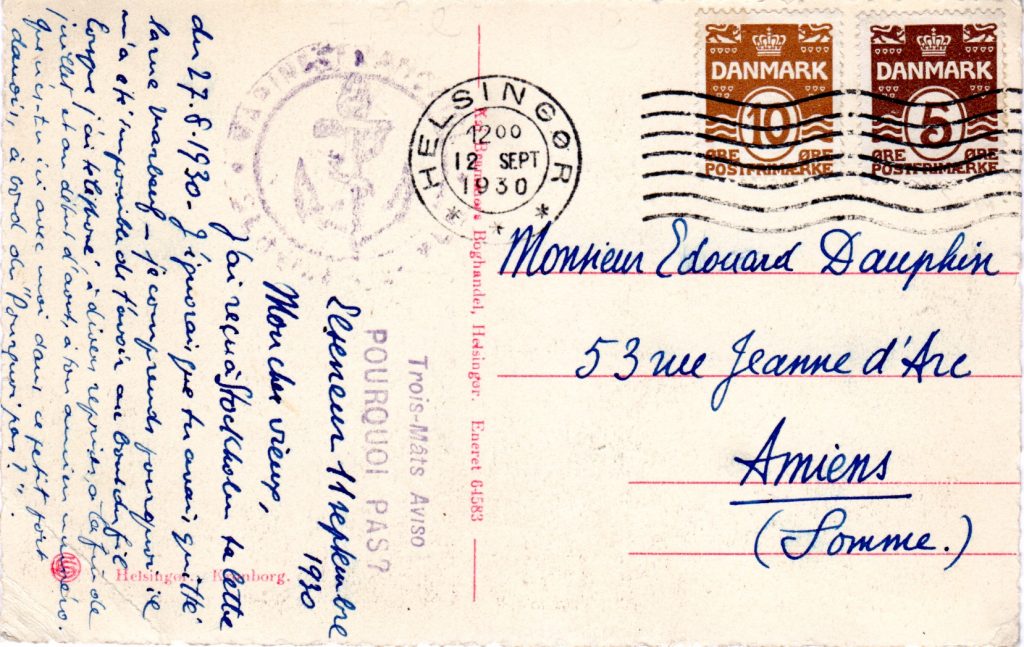
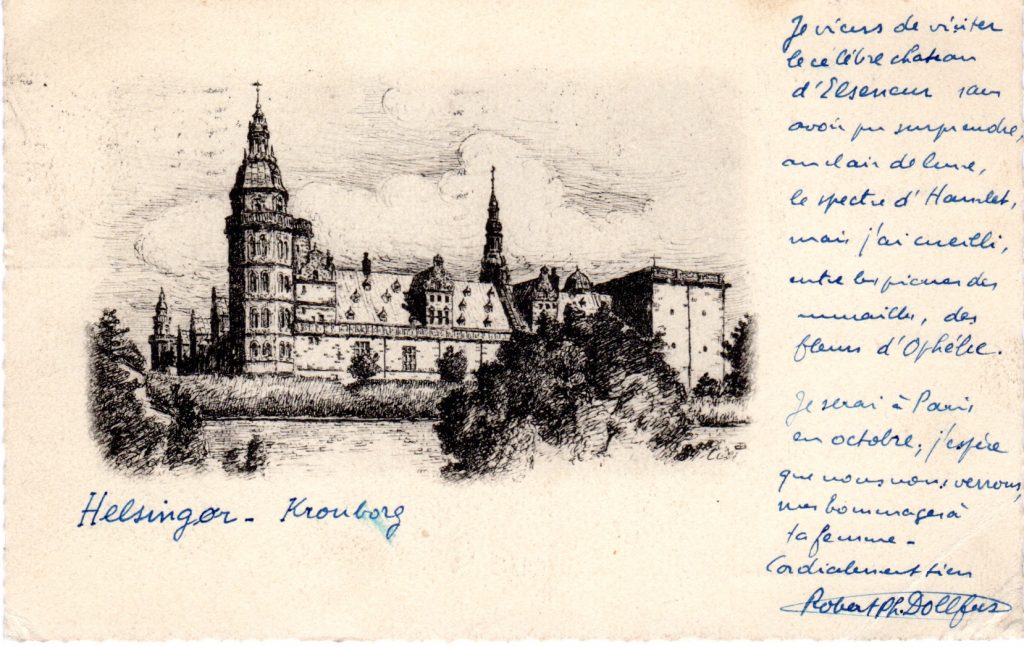
Fig. 1a & 1b – Postcard written by Charcot assistant Robert-Philippe Dollfus at Elsinore, 11 September 1930. Helsingør 12 September 1930 cancellation.
Message reads: “I received your letter in Stockholm… Why are you not here with me in this little Danish port on board Pourquoi-Pas?…”
International postcard rate (January 1927): 15 øre.
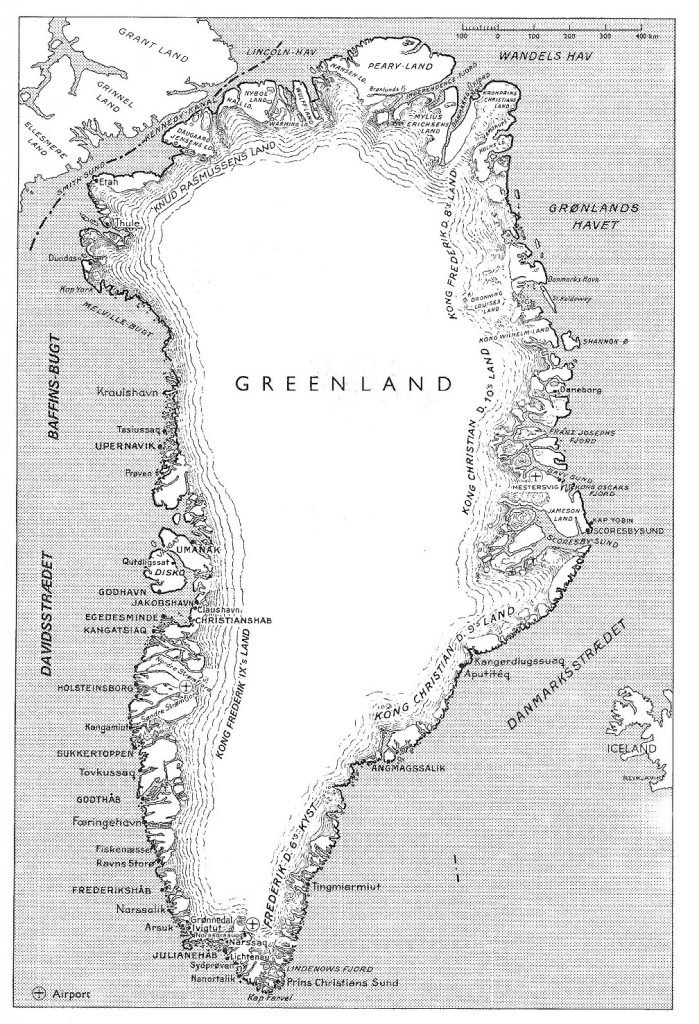
Fig. 2 – Map of Greenland

Fig. 3 – Detail of the Scoresby Sound

Fig. 4 – William Scoresby Junior
At the end of these meetings, the new Polar Year 1932-33 was established. The idea was to make in-depth geophysical and meteorological observations in many places around the world, particularly in the Polar Regions, for a year.
The French participation was studied by a commission chaired by General Ferrié, with Maurain as rapporteur. “The commission was guided in its study by the proposal made from the beginning to France by the International Polar Year Commission to establish a station in Scoresby Sound, on the east coast of Greenland, where Dr Charcot and his collaborators had already worked on several occasions, and by the importance of observations in regions of the earth other than the polar regions.”
Charcot notes: “The Bureau des Longitudes studied the Polar Year programme in detail and recognised its undeniable importance and great interest; this scientific undertaking was therefore placed under its high patronage and that of the Académie des Sciences. The Académie de Marine was also interested in this project. The Société de Géographie granted its patronage, a subsidy and a loan of instruments. The French Polar Commission did me the honour of entrusting me with the organisation of the only polar station, that of Scoresby Sound.”
In 1931 (fig. 5), Pourquoi-Pas? was to go to Scoresby Sound to allow Charcot to choose the location of the buildings intended for observations and living quarters, to prepare the latter and to make arrangements with the Eskimos for the help they could provide. The French Navy demonstrated its interest in the Polar Year by providing and facilitating the fitting out of Pourquoi-Pas? for this preparatory mission (fig. 6a & 6b).
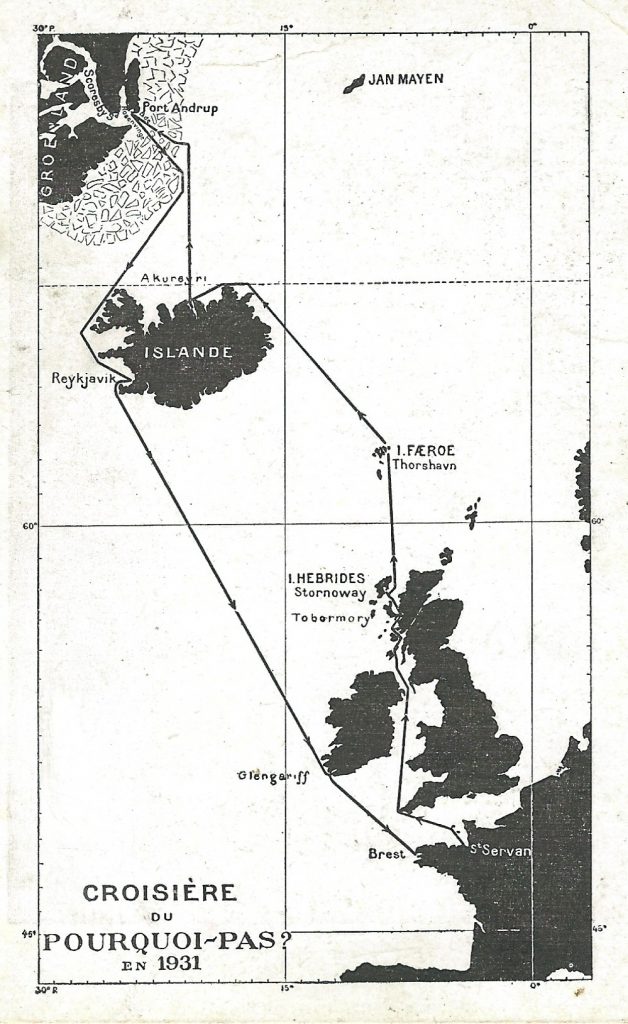
Fig. 5 – Postcard showing the route of Pourquoi-Pas? during the 1931 cruise with Port Amdrup, at the entrance to Rosenvinge Bay, Scoresby Sound.
Fig. 6a & 6b – Transition period letter-card written by Yann Habert, future leader of this party, on board submarine Pasteur in Brest, 10 March 1931, and sent to ensign Auzanneau who had been appealing to Habert for a position on the expedition.
Brest 11 March 1931 KRAG slogan cancellation.
Message reads: “I take note of your application…For the moment I’m not part of the 1932-33 polar expedition, I’m just encouraged by Charcot…”
Letter rate from April 1930 up to 20 grams: 50 centimes.
The departure from Saint-Servan takes place on 12 July. As the ice approaches, Charcot, always in control of the situation, specifies: “It was necessary to make way quickly and boldly, however with prudence and circumspection, by taking into account the wind and the drift of the ice. I cannot repeat too often that you cannot improvise yourself as an ice pilot. If similar ice floes were to come together, it could trap the boat and even lead to a disaster. From the top of the crow’s nest, sometimes one of us, sometimes the other, chose the channels, while from the bridge we avoided or pushed aside the obstacles. Only once did we fall into a dead end. The point of least resistance was judiciously chosen and we forced a hundred meters very hard to cross by using the usual means.” (fig. 7, 8 & 9)
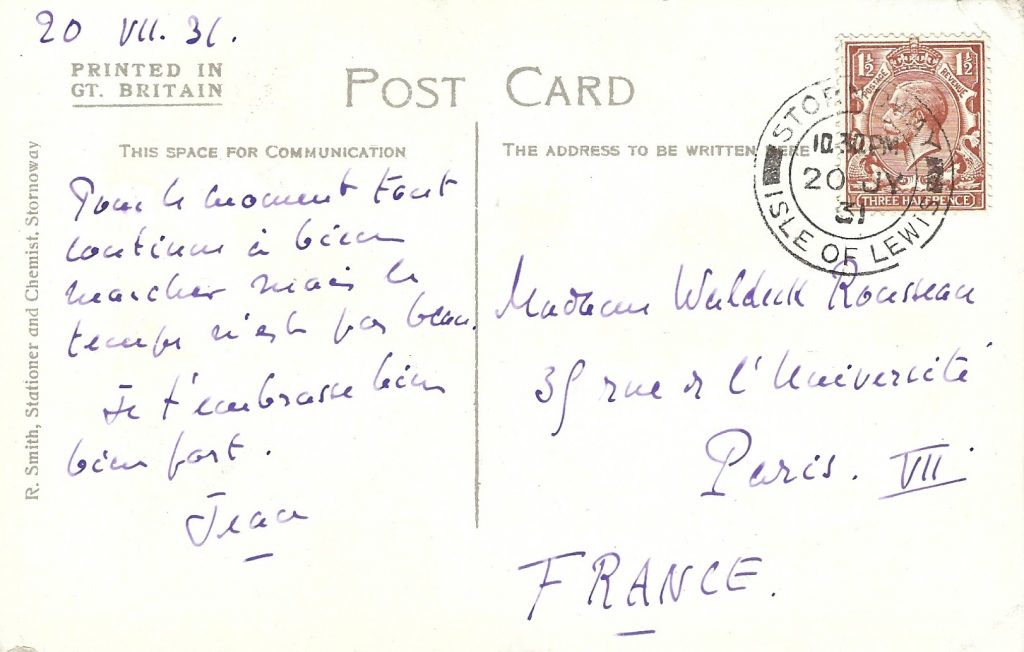
Fig. 7 – Postcard written by Charcot (signed “Jean”) from Stornoway, Isle of Lewis, Scotland, 20 July 1931. Stornoway 20 July 1931 datestamp.
Message reads: “For the moment everything continues to work well but the weather is not nice…”
International postcard rate from May 1929: 1½d.
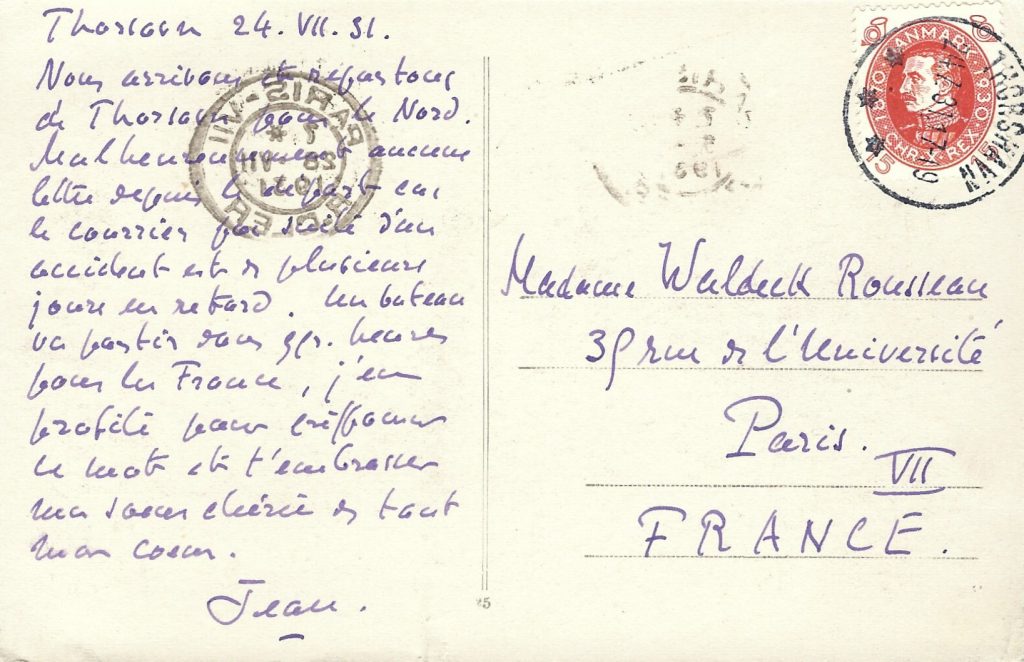
Fig. 8 – Postcard written by Charcot (signed “Jean”) from Thorshavn, Faroes, 24 July 1931. Thorshavn 24 July 1931 datestamp.
Message reads: “Well arrived in Thorshavn. We will leave for the North. Unfortunately no letter since the departure…”
International postcard rate from January 1927: 15 øre.
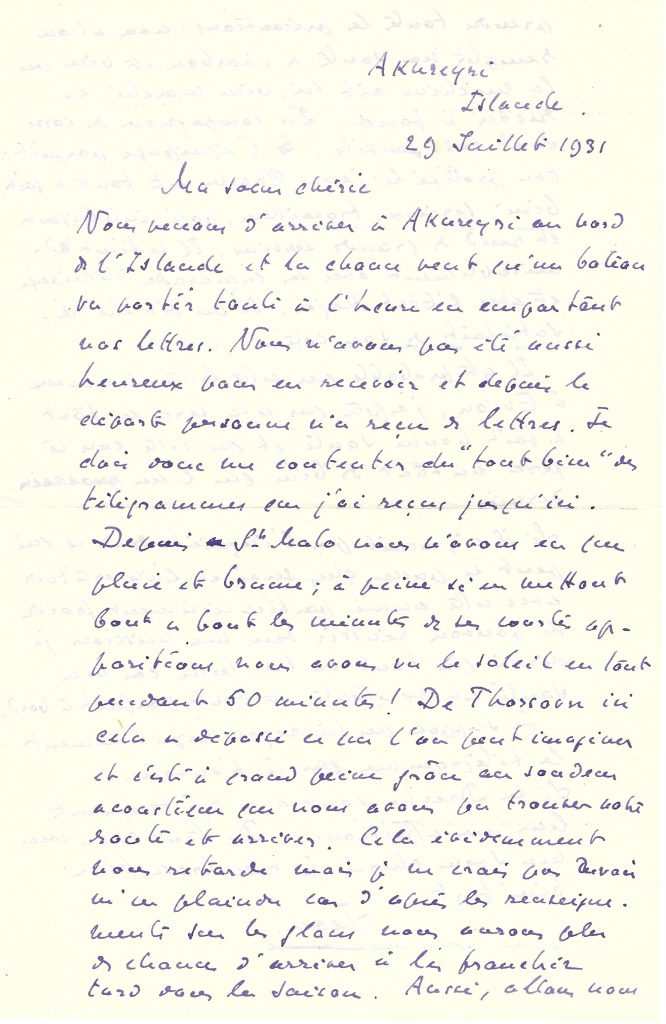
Fig. 9 – Letter written by Charcot to his sister when Pourquoi-Pas? arrived in Akureyri (Iceland) on 29 July 1931, en route to Scoresby Sound.
“We have just arrived at Akureyri in the north of Iceland and as luck would have it, a ship will be leaving shortly with our letters. We have not been so fortunate as to receive any and since departure no one has received any letters…”
Arriving at Scoresby Sound on 6 August, they met the three colony officials and a carpenter-architect provided by Ejnar Mikkelsen (fig. 10). Charcot says: “In a few moments we were all friends… I did not have to show the authorization that Denmark very sensibly requires allowing foreigners to land in Greenland. At my request, the governor repeated to me what we already knew: staff and crew could disembark and move about freely, but, as head of mission, I had to ensure:
- that no man with a contagious disease would go ashore and that there would be no intimate relations with Eskimo women;
- that no alcoholic beverages were given to the natives; only half a small glass of rum could be offered to those who came on board for the first time;
- that there was no purchase or exchange of furs or ivory, the Danish government finding by the exclusive sale of these products that it reserves for itself a very small remuneration for the very large sums it spends generously for the welfare of its Greenlandic colony; purchases of small objects made by the Eskimos were allowed.”
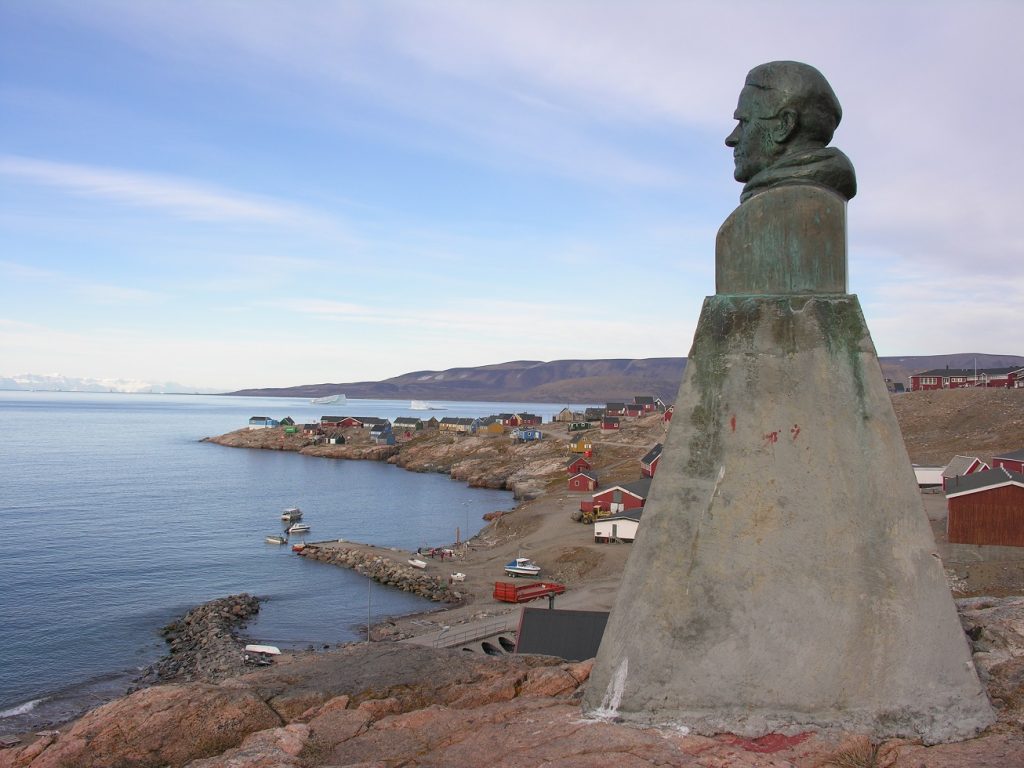
Fig. 10 – Bust of Ejnar Mikkelsen (1880-1971), Danish polar explorer and friend of Charcot, overlooking Rosenvinge Bay. Photograph by Serge Kahn.
The Danish supply ship Gertrud Rask, which had arrived a few days earlier, had unloaded the equipment from the dwelling house. Now the concern is to find a location for the aerological observatory, on a peak that is not too far away and relatively easy to reach. This task fell to Louis Gain, who chose a peak at an altitude of 420 m, close enough to the main base station to allow communication by optical signals. This observatory was named Ker Virginie in memory of its donor. Noting that the three members of the mission living in this observatory would be easily supplied and that the scientific work could be carried out in a practical manner, Charcot expressed his satisfaction: “For the first time in my now long career as a navigator, I have been able, not without a satisfaction that I will not try to conceal, to radiotelegraph in France the word of my code meaning: we have succeeded beyond our expectations!”
Once again, relations with the Eskimos are excellent. Friendly, intelligent and helpful, they came to do manoeuvres and acrobatics around Pourquoi-Pas? in their kayaks or to spend a few hours on board. It is not without emotion that Charcot confides: “I hope that these good people will keep as excellent a memory of our visit as the one we took away. I cannot resist the desire to express, not only my personal opinion, but that of the whole crew on the admirable and totally disinterested work of Denmark in Greenland. How often have I heard one or other of our sailors exclaim with the rough simplicity but good sense of the street man, “What a fine country this Denmark is, which makes so much effort, risks a ship every year through the ice, and spends so much money to succeed in making civilised and happy men.”
The 1931 campaign thus achieved its main goal by determining the location of the installations and by transporting the material necessary for their foundations and construction in the best possible conditions. On his return, Charcot showed an enthusiasm that was a fine reward for his total commitment to the service of scientists: “Our navy and our scientists will prove equal to the task they have taken on. The Antarctic expeditions of 1903-05 and 1908-10 were the first and only long-lasting French polar events; with the greatest confidence I hand over to the young.”
For Charcot, the Scoresby Sound is a bit like home. But he is now in this process of initiating his successors and he shares “his inviolate fiefdom, perhaps not without intimate heartbreak but certainly without pettiness.”
2 – The French Presence 1932-33
Limited but sufficient credits were voted by the Parliament in December 1931; the Commission could then entrust scientists with the instruction and training of the members of the mission and distribute the sums necessary for the purchase of instruments.
This mission, under the responsibility of Lieutenant Habert, was composed of:
- Dauvillier, in charge of studies concerning the polar auroras, the earth’s electric field, the conductivity and ionisation of the air, cosmic rays and the solar ultraviolet;
- Rothé, in charge of observations concerning terrestrial magnetism and telluric currents, as well as geological research;
- Tcherniakowsky, in charge of biological studies;
- Ensign Auzanneau, in charge of meteorology and cinematography;
- Lieutenant Douguet, in charge of radioelectricity, meteorological radiosoundings and hydrography;
- Doctor 1st class Le Méhauté;
- Second Master Monniot, in charge of radiotelegraphy;
- A team of naval quartermasters completed the mission:
- two radio telegraphists: Chapelain and Garrigou;
- two electricians: Henry and Lozahic;
- two mechanics: Broudin and Delaporte;
- a cook: Le Diraison.
The mission’s equipment, which initially was not to exceed 100 tonnes, amounted to 400 tonnes, including 90 tonnes of coal and 25 tonnes of petrol. Pourquoi-Pas?, which was sufficient to transport 100 tonnes, could not handle this new tonnage. It is thus necessary to have recourse again to the French Navy. Charcot explains: “The usual ice belt, which forbids access to the east coast of Greenland for ordinary ships, required the use of a special vessel. Pollux, an icebreaker of 1,500 tons and 4,000 hp, which had been used during the war to maintain communications with Arkhangelsk, was the ideal vessel. Since transformed into a mine anchor, it was decided that she would temporarily resume her initial role, and command was entrusted to Lieutenant-Commander E. Mailloux.”
Pollux embarks in Brest all the equipment of the polar station, as well as its members. The holds of Pourquoi-Pas? were reserved for 50 tons of coal and to take most of the equipment bought in Denmark from the Faroes. Under these conditions, Pourquoi-Pas?, while contributing to the installation of the Polar Year mission, could, as in previous years, engage in scientific research and observations (fig. 11).
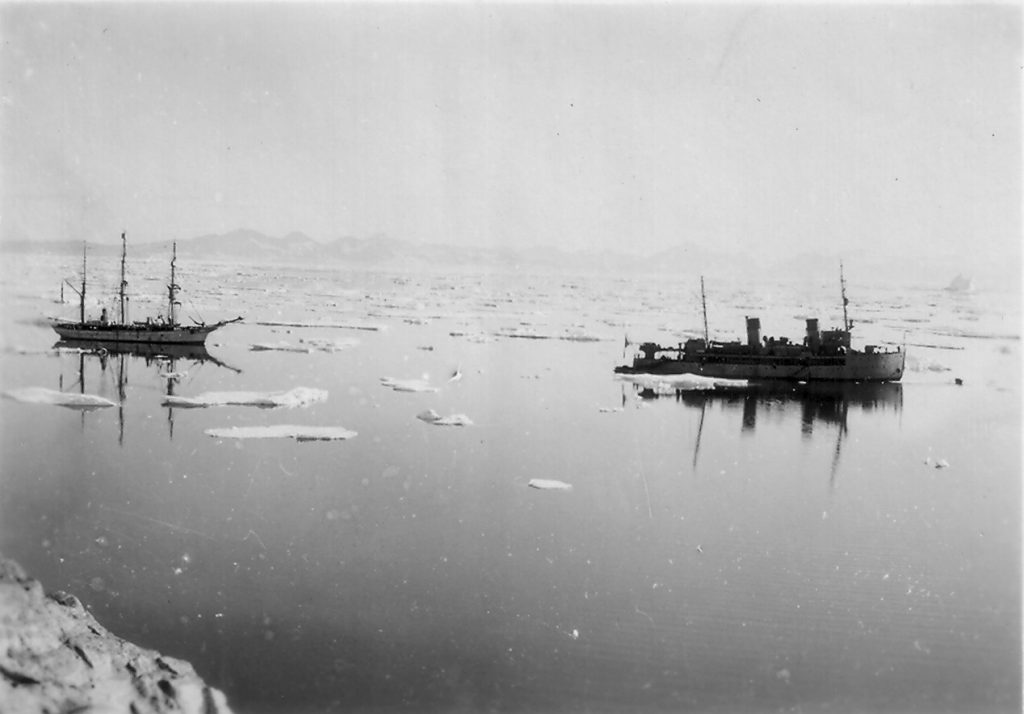
Fig. 11 – Pourquoi-Pas? and Pollux in Rosenvinge Bay at Scoresby Sound.
In Saint-Servan, Pourquoi-Pas? embarked her equipment as well as various boxes intended for the mission and two dories whose practicality Charcot praised: “I had these boats built for the Scoresby Sound with full knowledge of the facts, since my ship has always used them. There is no more practical boat for ice. Their insignificant draught enables them to be sailed over the shallow water in the channels which are frequently found between ice and land; their lightness enables two men to pull them ashore or on the pack ice, where their flat bottom slides easily; they can, moreover, be put on light Nansen sledges. Inverted over a hole in the snow, they make excellent temporary accommodation, quickly prepared, or a food cache. Their qualities at sea no longer need to be praised. Coupled two by two with planks, they form rafts that can carry up to three tons.”
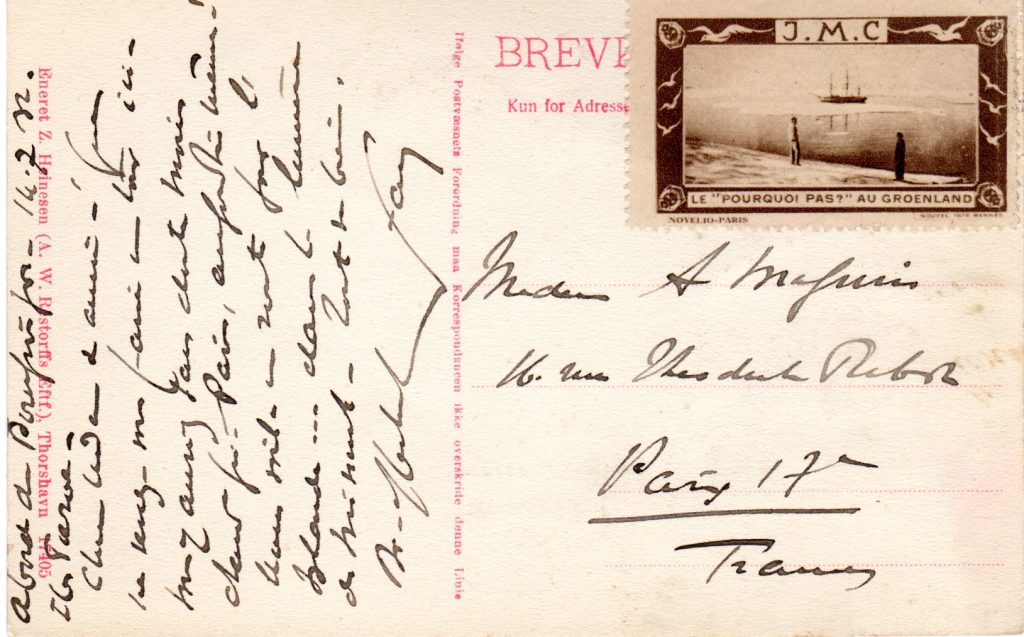
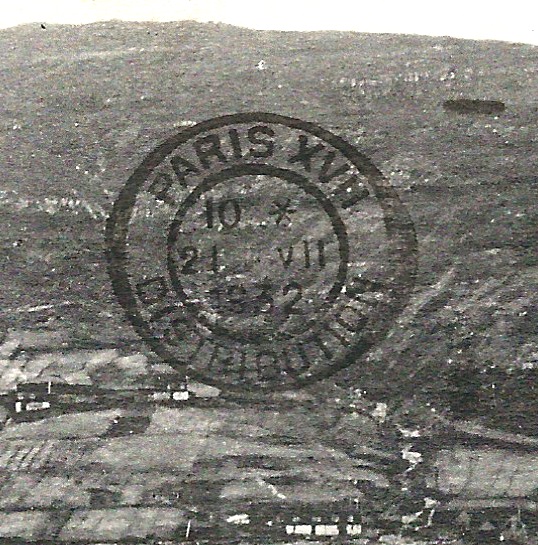
Fig. 12a & 12 b – Postcard written by expedition member J.-L. Faure, on board Pourquoi-Pas? from Thorshavn, Faroes, 14 July 1932, en route to Greenland. Passed through the mails with just one of two expedition vignettes.
Paris 21 July 1932 arrival datestamp on the back.
A few days later, Pourquoi-Pas? anchors in Stornoway. This herring capital is picturesque for its harbour, which is bursting with activity when the boats return from fishing. The herrings are piled up in hundreds of barrels lined up on the quayside; the sorting is done by women who, with one stroke of the knife, tear off the gills of the fish before salting and packaging them for export. Then it was Thorshavn, where Pourquoi-Pas? docked opposite the shed where the equipment from Copenhagen was stored: polar clothing, shoes, bed-sacks, sledges, tents, pemmican, timber, etc., chosen by Mikkelsen in agreement with Charcot, who noted: “Everything is first rate.”
Let us leave it to Charcot to tell us the continuation of the voyage from the Faroe Islands: “On 16 July, we set sail at midnight and arrived in Akureyri harbour on the 18th at 6.30 pm. There we joined Pollux, which had left the Faroes before us. […] Akureyri was our point of departure for Greenland; the two ships had to complete their supplies and those of the mission, and ensure that they had enough water and coal. Pollux had already completed this last operation; Pourquoi-Pas? went to the quay and carried it out quickly. Everything was facilitated by the kind activity of our kind and excellent consular agent, Mr. Karl Nikulasson (fig. 13 & 14). In this well-sheltered harbour we had to wait for news of the condition of the outer ice and that of Scoresby Sound before leaving for Greenland. In order to stay as long as possible in Rosenvinge Bay, we had to make the journey in conditions that would spare our coal.” It is here, before setting sail, that Pourquoi-Pas? shows an unusual silhouette after having embarked, with much difficulty, one of Lauge Koch’s two seaplanes for the Scoresby Sound. Charcot did not shy away from these complications to please the Danes.
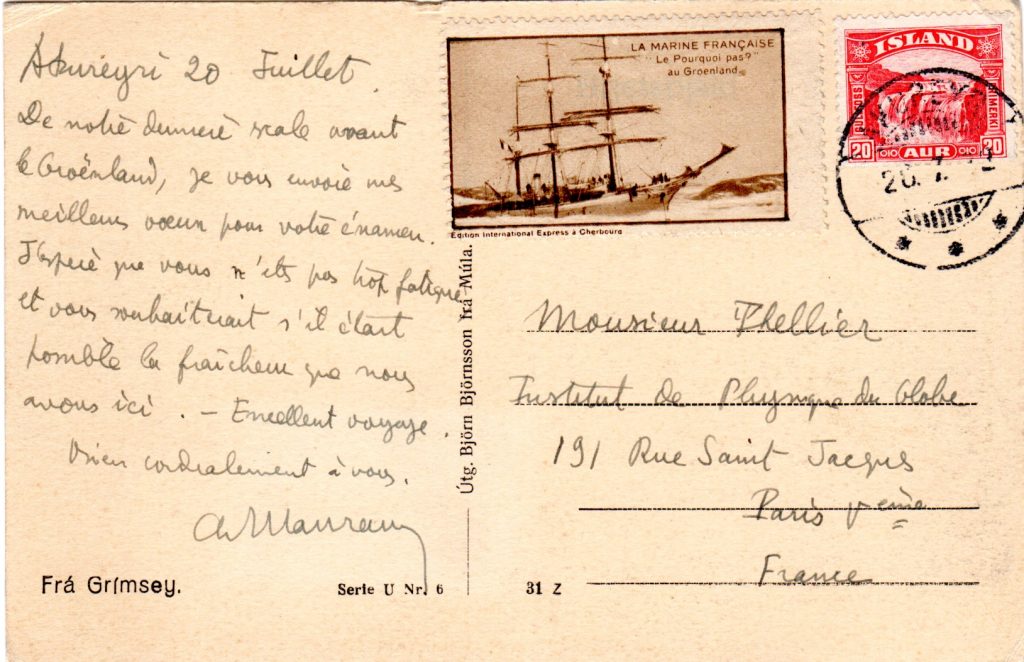
Fig. 13 – Postcard written by expedition member Charles Maurain from Akureyri, Iceland, 20 July 1932.
Akureyri 20 July 1932 datestamp.
Another type expedition vignette, issued in Cherbourg, showing Pourquoi-Pas? in Greenland.
This vignette exists also in green (fig. 14).
Message reads: “From our last stop before Greenland…”
International postcard rate from October 1925: 20 aurar.

Fig. 14
Between Iceland and Greenland, Pollux and Pourquoi-Pas?, a few metres behind, slowly roll from one side to the other. Little by little, the 2,000-metre peaks that border Scoresby Sound, to the north and south, become more and more visible. It was a slow sail in a very dense pack where the fog banks allowed the two ships to play hide and seek. Ensign Simottel of Pollux notes: “[…] Pourquoi-Pas? suddenly reappears 100 m ahead: she has reduced her speed and we follow her, as the ice is very difficult to see in the fog. At 11 o’clock she stops near a huge iceberg which she must have brushed, and Charcot tells us that he prefers to stop, given the uncertainty of our position.”
For their arrival on 26 July, the sky cleared and became wonderfully pure, the sea was calm and the sun bathed them in pleasant warmth. Three kayaks came to meet them as they saw Rosenvinge Bay; Gertrud Rask was in the harbour (fig. 15).
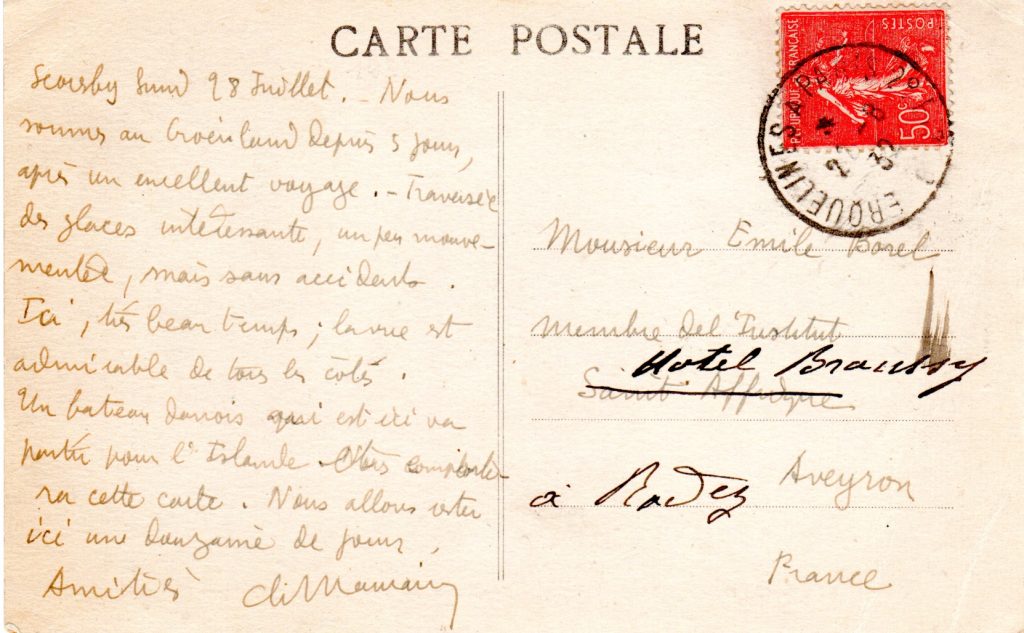
Fig. 15 – Postcard written by Charles Maurain in Scoresby Sound, Greenland, 28 July 1932.
Message reads: “We are in Greenland for five days after un excellent trip… A Danish ship that is going from here to Iceland carries this postcard…”
Mail carried by Danish ship Gertrud Rask from Greenland to Iceland and then aboard another ship to Belgium (Antwerp) and by rail to Paris. Not cancelled until entering French postal system.
TPO “Erquelines à Paris” 22 August 1932 datestamp.
Pollux and Pourquoi-Pas? arrive at the anchorage at the same time. The end of this day is mostly occupied with receiving and paying visits. Charcot meets again the civil servants from last year, who have become and remain friends: Hoegh, the governor, Kaldahl, in charge of the seismological and meteorological observations and the radio station, and Abelsen, the pastor-teacher. The carpenter-architect Hansen comes to announce to Charcot that the constructions of the main station (fig. 16) and the aerological station are completed.
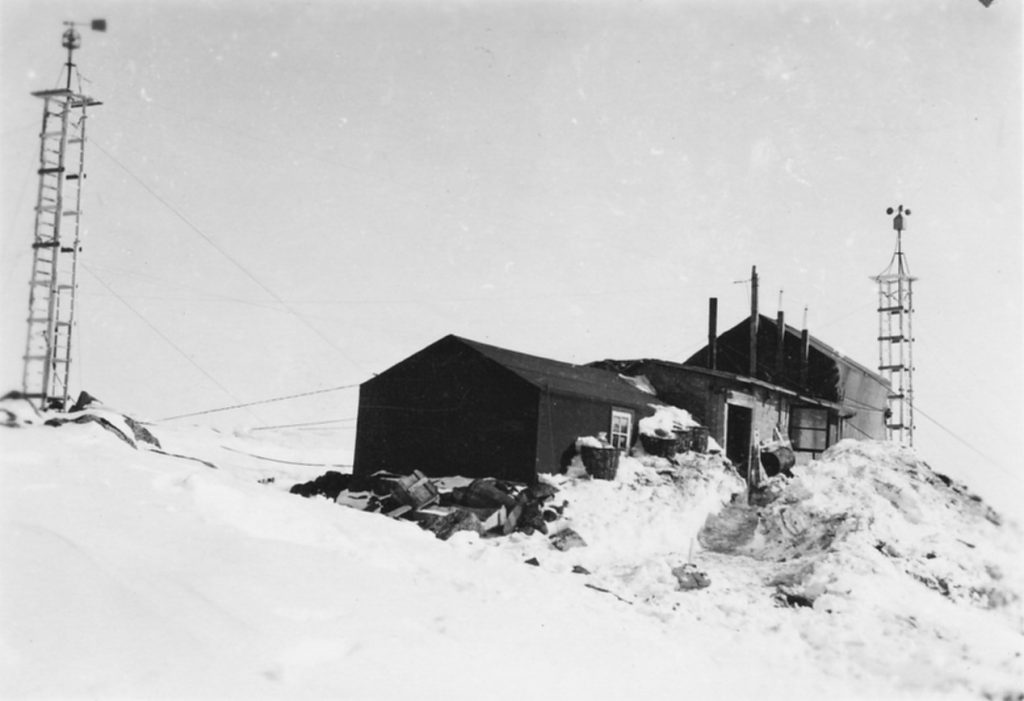
Fig. 16 – The three buildings of the main station, also called Paul Doumer station.
The Hydrographic Service of the Navy gave as instructions to the French mission to focus especially on the part of the Sound visited by ships. The Danes did not hide from Charcot the satisfaction they would feel to see this useful work seriously and definitively carried out, thus allowing them to finalize their charts. Charcot thinks that it would be a way to show the gratitude of France for the hospitality so kindly offered by Denmark (fig. 17a & 17b).
Fig. 17a & 17b – Letter-card written by Charcot (signed “Jean”) in Scoresby Sound, Greenland, 28 July 1932.
Paris 22 August arrival datestamp. Mail redirected to Evian with arrival on 23 August 1932.
Message reads: “Unexpected opportunity. The Danish ship leaves today and will carry this letter to be mailed I don’t know where or when but certainly before our return to Reykjavik…”
Four days were enough to unload the 400 tons of equipment. Charcot reports the following anecdote: “Out of the 300 tons unloaded from Pollux, only one medium-sized box fell into the water at a depth of 25 meters. We tried in vain to dredge it with our instruments. None of the members of the mission having ever been able to tell us what it contained, we concluded that this loss was of no importance.”
The transport and construction work began. Charcot sends Parat, Devaux and Drach to mark out the best route to the aerological observatory in order to transport the equipment to Ker Virginie. All the available men are active in a landscape of great beauty. It is a magic of colours, these mountains lit by the setting sun and these sparkling icebergs! An enchantment that gives courage for the climbs to Ker Virginie, which is adorned, next to the national flag, the special pennant, made on site, of this great yachting enthusiast.
By the end of July, Lauge Koch came by air. The 87 seaplane, twin brother of the 86 that Pourquoi-Pas? had transported from Iceland with its pilot Harms, came to land in Rosenvinge Bay. Lauge Koch comes from Ella Island, a hundred miles to the north, where he has established his work centre and is busy clarifying the map by photographic surveys. Charcot, who had a great deal of friendship and admiration for this explorer, invited him to dinner on board Pourquoi-Pas?.
Lauge Koch pointed out a place at Cape Leslie (Milne Land) where fossils of great importance for the geological history of Greenland were found in abundance. In mid-August, on a calm but overcast day, Pourquoi-Pas? set sail and picked up two Eskimos at Cape Hope who were to act as guides to the fossil field. Charcot soon sailed along Jameson Land, a rather low and bare coastline on which a few groups of almost black musk oxen could be seen. As Pourquoi-Pas? moves deeper into the fjord, the icebergs become more numerous and larger. The Milne Land has the advantage of bringing together in a relatively small space all the geological formations of the region: sedimentary terrains, basalts, granites and gneisses.
Fig. 18a & 18b – Cover in the handwriting of ensign Auzanneau, member of the French Mission in Scoresby Sound, carried by Pollux and sent from Copenhagen, 19 August 1932.
Type II circular cachet of the mission. MARINE FRANÇAISE red circular cachet.
SCORESBYSUND magenta single line colony postal marking.
International letter rate from January 1927 up to 15 grams: 25 øre.
On the front, circular postmark (Type II) of the mission, used in Greenland with the text: MISSION FRANÇAISE DE L’ANNÉE POLAIRE / 1932-1933.
Type I, used in the Paris offices, reads: MISSION OFFICIELLE FRANÇAISE de l’ANNÉE POLAIRE / 1932-1933.
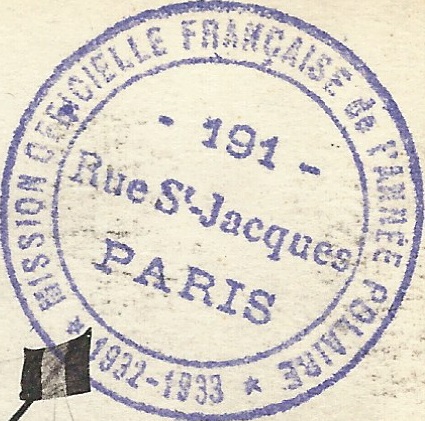
Type I 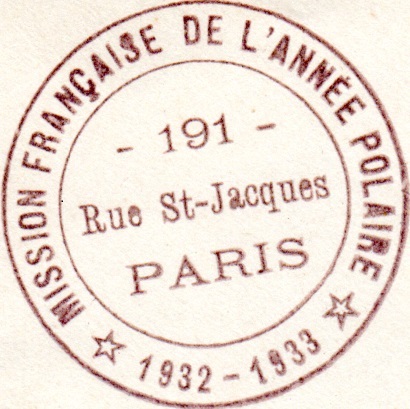
Type II
On the day scheduled for the departure of Pollux (fig. 18a & 18b), a parade, for the definitive inauguration of the Paul Doumer station, was carefully organised by Commander Mailloux, followed by a medal presentation, an address and a glass of champagne. At noon, a lunch, prepared with the greatest care by the mission’s cook, was served in the open air on makeshift tables set up among the rocks. The same menu was served to everyone, from the humblest sailor to the most senior officers and members of the Institute. Lieutenant Habert presided over the meal, with Charcot on his right and Maurain on his left (fig. 19).

Fig. 19 – Lunch on 11 August 1932 offered by the Polar Mission to the crews of Pourquoi-Pas? and Pollux. Charcot is in the foreground, back with a hat, having on his left the Lieutenant Habert.
Charcot decides to stay until the extreme limit of his coal. After a festive evening on board, Pourquoi-Pas? set sail on 21 August, greeted by three cannon shots fired by the governor. Three whistles from the siren tore through the air and, with a clench in his heart, Charcot moved away from what he had dreamed of for a long time and finally created: the official participation of his country in polar endeavours! This dream that has become reality is like the crowning achievement of his work (fig. 20).
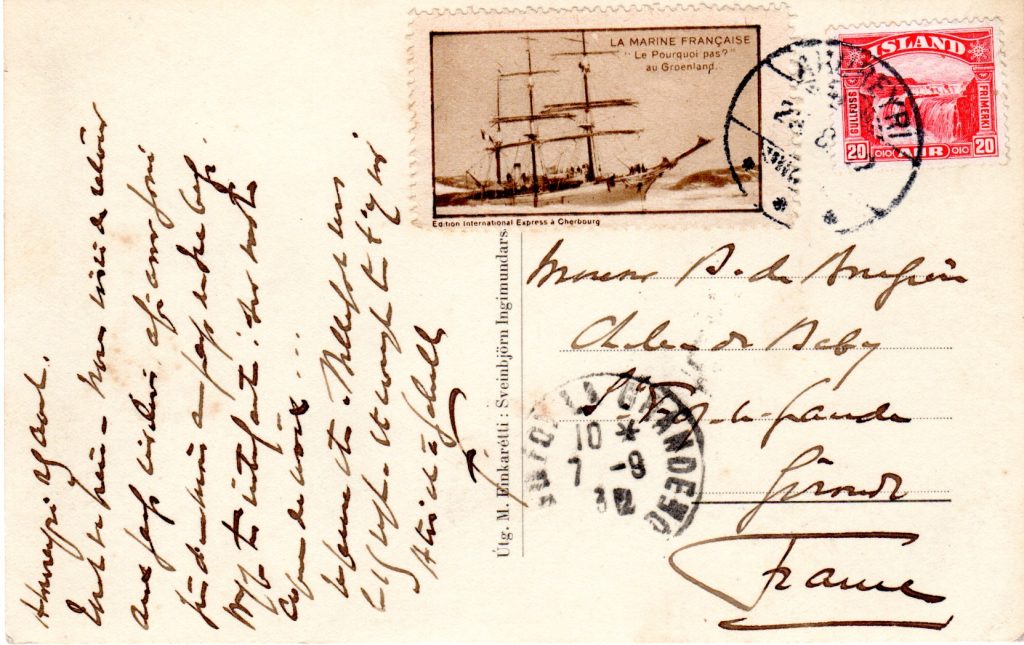
Fig. 20 – En route back postcard written by J.-L. Faure from Akureyri with 25 August 1932 datestamp.
Vignette showing Pourquoi-Pas? in Greenland.
Sainte Foy la Grande 7 September 1932 arrival datestamp.
Message reads: “All is well. We’re back to civilised countries…”
Once back in France, Charcot will follow the scientific work of the French Mission, led by Lieutenant Habert, who stayed in Scoresby Sound for one year, in liaison with Admiral Habert in Paris, the latter’s father (fig. 21a & 21b).
Fig. 21a & 21b – 22 November 1932 telegram from Charcot to Admiral Habert that fire at Danish telegraph station would affect communications with the French Greenland station.
Datestamp of the sending office PARIS CENTRAL of 22 November 1932. On the back, datestamp of the delivering office PARIS 52.
The year 1933 saw the return to France of the polar mission installed at Scoresby Sound and its equipment. In a note dated 10 May 1933 addressed to Admiral Le D’O, Prefect of the 1st maritime region of Cherbourg, the Chief of the Naval Staff Durand-Viel specifies: “1° I have decided to send Pollux to Scoresby Sound during the summer of 1933, to bring back to France the personnel and the equipment of the polar mission. 2° This ship will leave Cherbourg around the 1st of July to join Pourquoi-Pas ? in Shetland or Iceland. Detailed instructions for the crossings will be sent to you later.”
That same year, three young English researchers, commissioned by the Scott Polar Research Institute of Cambridge University, found themselves in Akureyri without any means of communication with the east coast of Greenland, where they wished to go. They were G. C. L. Bertram, D. L. Lack (fig. 22) and B. B. Roberts of the Cambridge Zoological Expedition. Charcot took them on board as “personal guests” and deposited them with their study and camping equipment at the bottom of Hurry Inlet. They were recuperated eighteen days later after having accomplished some interesting work and were deposited by Pourquoi-Pas? in Tobermory, Hebrides, at the beginning of September. They brought back to England many results but also the happiest memories of this voyage and of the French.
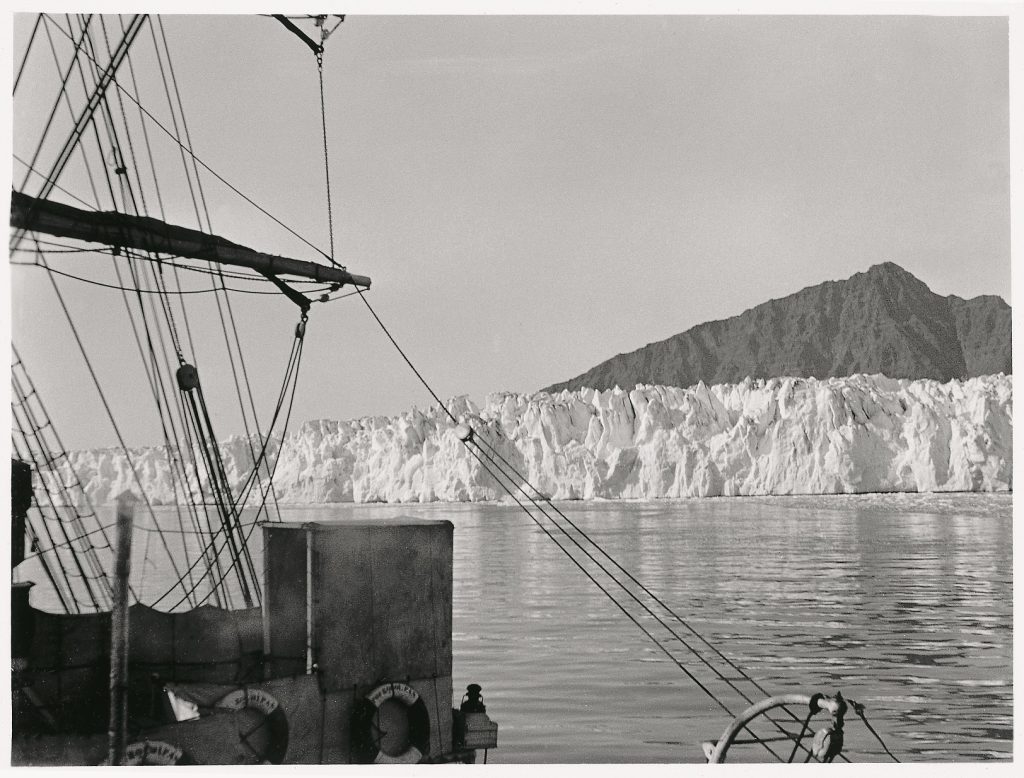
Fig. 22 – Photo of the Blosseville coast, south of Scoresby Sound taken by David Lack from Pourquoi-Pas? ’s deck.
In mid-August, before embarking on Pollux, the polar mission erected, instead of the traditional stone cairn, the Doumer column. These are empty oil cans (fig. 23), forming a hail column ten metres high, supported by stays; at the base, a plate fixed on a wooden box… Rust will soon have eaten away the tin and the stays, the wood will rot, the wind will complete the wreck… but it is modern.

Fig. 23 – Cans found on site by the author of the article, September 2005. Photograph by Serge Kahn.
On his way back, Charcot found an ice-free sea and was therefore able to sail along the Blosseville coast and make a few landings on this inhospitable coast between 20 and 22 August. Pourquoi-Pas? arrived in Reykjavik on 24 August and Charcot wrote a five-page letter to his sister in which he could confide in her (fig. 24a & 24b). Then a stopover in Tobermory and the arrival in Brest on 6 September 1933 (fig. 25a & 25b).
Fig. 24a & 24b – The first two pages of a five-page letter from Charcot to his sister with some feelings about the work done and the French mission that stayed a year in Scoresby Sound.
“We made a fruitful and beautiful voyage in spite of the often very bad weather conditions. I will not speak of the Polar Year mission; it gave me nothing but disappointment and disillusionment. Habert may have a mathematical mind, but he is a fool, vain and unscrupulous…”
Fig. 25a & 25b – Telegram from Danish Scoresby Sound station to Habert in Paris, forwarded by post from Copenhagen to Paris, once the French mission was back home. Datestamp of 17 December 1933. STATSTELEGRAFEN red vignette on the back.
International letter rate from November 1933 up to 15 grams: 30 øre.
As usual, Charcot will promote French science by highlighting the total involvement of the French Navy in the international polar cooperation that was the 2nd International Polar Year, through articles and lectures (fig. 26).
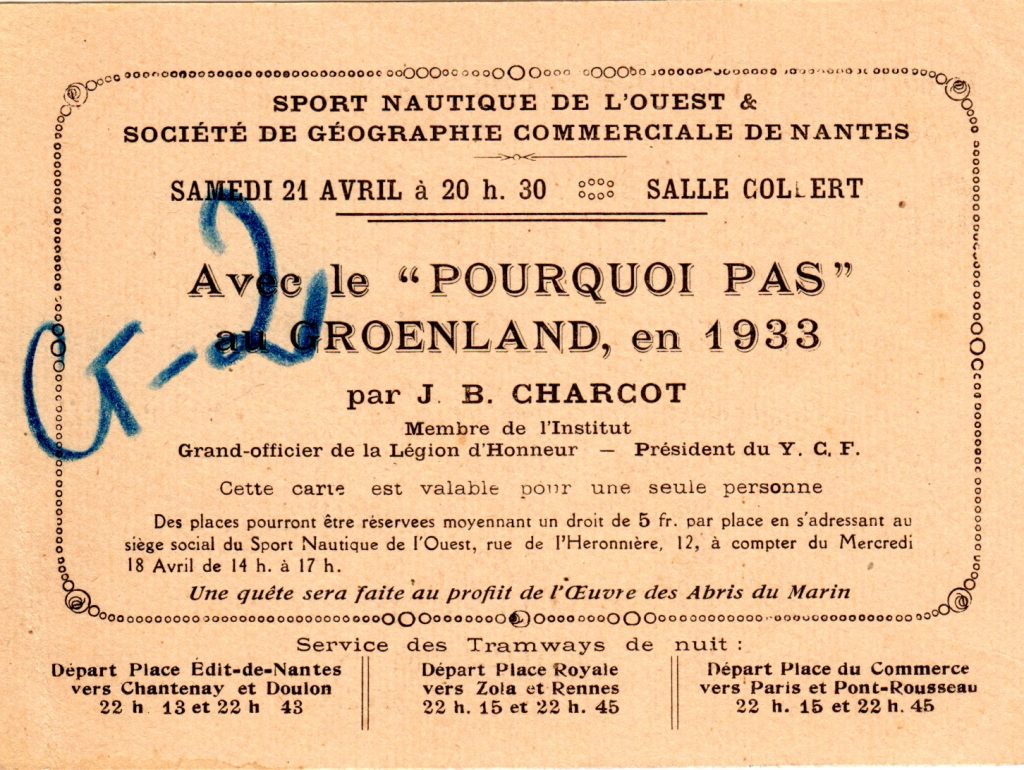
Fig. 26 – Invitation card for a lecture by Jean-Baptiste Charcot about the 1933 Greenland campaign.


